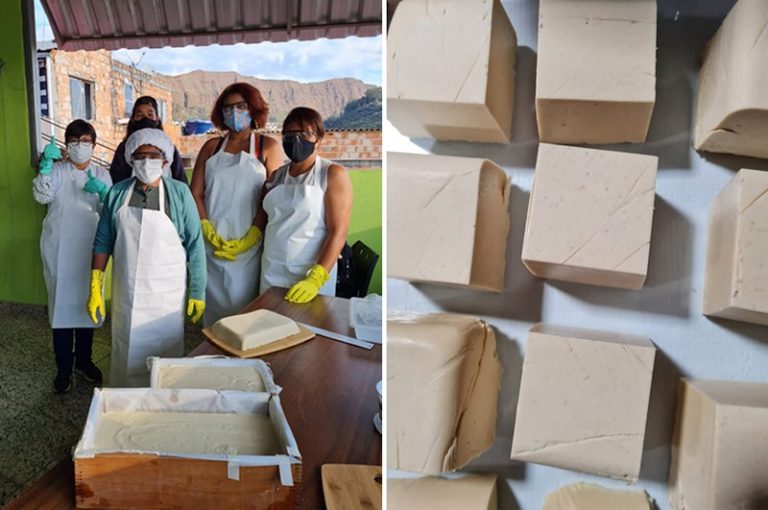
Feeling urge to help her community fight the pandemic, Francischi started producing bars of soap from her home for washing and disinfecting.
Patrícia Maia Noronha
Turning used cooking oil into aromatic soap bars might sound like alchemy. But that’s precisely what Janetti Francischi, a retired pharmacologist, has been doing since November 2020, distributing the soaps in her local community of Belo Horizonte, Brazil.
Inspired by her mother, who was a pharmacist, Francischi pursued a bachelor’s degree in biomedical sciences and a master’s degree in pharmacology at the University of São Paulo (USP). She also earned a PhD there, studying a specific type of white blood cell, the macrophage, and its role in peritoneal inflammation.
After 32 years as a professor at the Federal University of Minas Gerais, where she taught more than 5,000 students in subjects ranging from odontology to veterinary medicine, Francischi retired in 2017.
When the COVID-19 pandemic hit in 2020, Francischi decided to put her teaching and pharmacology expertise to work again. Brazil has been hit hard: as of May this year, the SARS-CoV-2 virus had claimed more than 660,000 lives in the country.
Feeling an urge to help her community fight the pandemic, Francischi started producing bars of soap from her home for washing and disinfecting. Based on a memory from her childhood, she repurposed used cooking oils, such as sunflower and olive oils.
How did you come up with this idea of collecting and transforming oil into soap?
My husband of 30 years died in an accident in 2016, and his absence affected me deeply.
My husband was the one who used to take care of the domestic tasks. I never asked what he did with our cooking-oil waste. After his death, I saw the bottles of used oil piling up in the kitchen and wondered what to do with them. I also had this distant memory of my grandmother making soap out of our used oil. But I didn’t have the ‘recipe’.
My youngest son says people can learn anything on YouTube. I gave it a try. I watched a few videos and then tried the process at home. I approached it like a laboratory experiment. I measured the quantities of the ingredients, took note of the times, and registered the pH of the soap. It’s ready to use when it reaches neutral pH after about a week, when it changes color from yellow to white.
In this way, I fused three goals into one — to help my community control the spread of the virus, save money and reduce environmental contamination with oil.
How does this ‘magic’ happen? What are the steps?
The first step is to drain the oil with a cloth to remove any residues – a simple kitchen cloth will do the job. After that, you heat water to near boiling point and add caustic soda flakes, or sodium hydroxide, mixing it very well until they dissolve.
Safety is key in this procedure because caustic soda is very corrosive. You must protect yourself from head to toe with goggles, gloves and apron. You also need to protect your feet – something I forgot on my first try.
Then, you add the cooking oil. This is the most challenging part because the mixture must be stirred with a stick for 40 minutes, until it becomes homogeneous. This is where I added a little something that makes all the difference: I started using an electric hand-held blender, and now this step is done in five minutes.
In my recipe, I also add a little washing-up detergent to increase foaming and some washing powder for aroma. When the mixture reaches the tracing point — when the oil and caustic soda form an emulsion and will no longer separate — we pour it into a rectangular plastic mould, and five hours later it’s ready to cut. After cutting, it needs to dry for at least a week.
How do you collect the cooking oil and distribute the soap?
I started by asking my family, friends and neighbors. But soon the network became wider. I got in touch with small businesses, such as street food sellers, and now I collect their used oil.
I distribute the soap in churches, which have a big influence in Brazil. People come, bring their bottles of oil and return later for their soap. One liter of oil waste turns into about ten bars of soap. This soap can be used for dishes and laundry, but also for hand and body washing.
You’ve led workshops to teach soap-making. How did that go?
I partnered with the non-governmental organization Seu Vizinho, which promotes educational, social and cultural activities in the neighborhood of Aglomerado da Serra, which is an impoverished area in Belo Horizonte where even basic items such as feminine-hygiene pads can be considered a luxury.
I designed four workshop sessions in the summer of 2021. We provided all the materials – the ingredients, blender, buckets, goggles, gloves and aprons for the participants.
The participants brought their own cooking oil. When we drained the oil, I noticed it had more residues than I expected from being used repeatedly so many times. That touched me a lot. I showed them how they could let this residue – which is very high in protein – dry and then reuse it, for instance, to feed animals.
They were astonished with the results, and I’ve been contacted again to do a new workshop on soap varieties. I also left all the materials at the community, so they can make soap anytime they wish.
I do this work as a volunteer. It’s a way of giving back to society. I hope to continue with this project for the rest of my life.
___________________
Courtesy: Nature